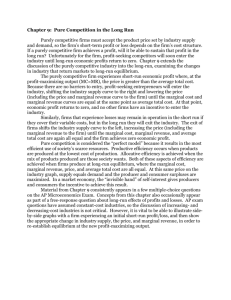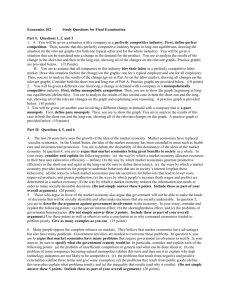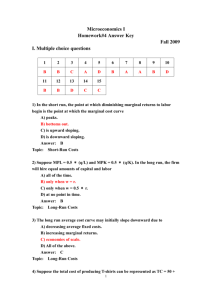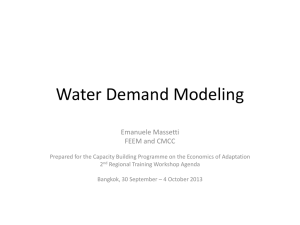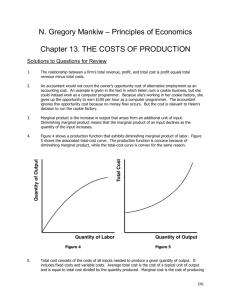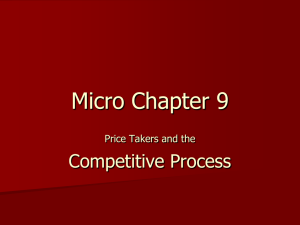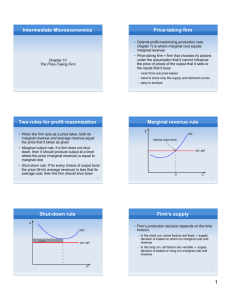Microeconomics Cost Practice Problems & Key
advertisement
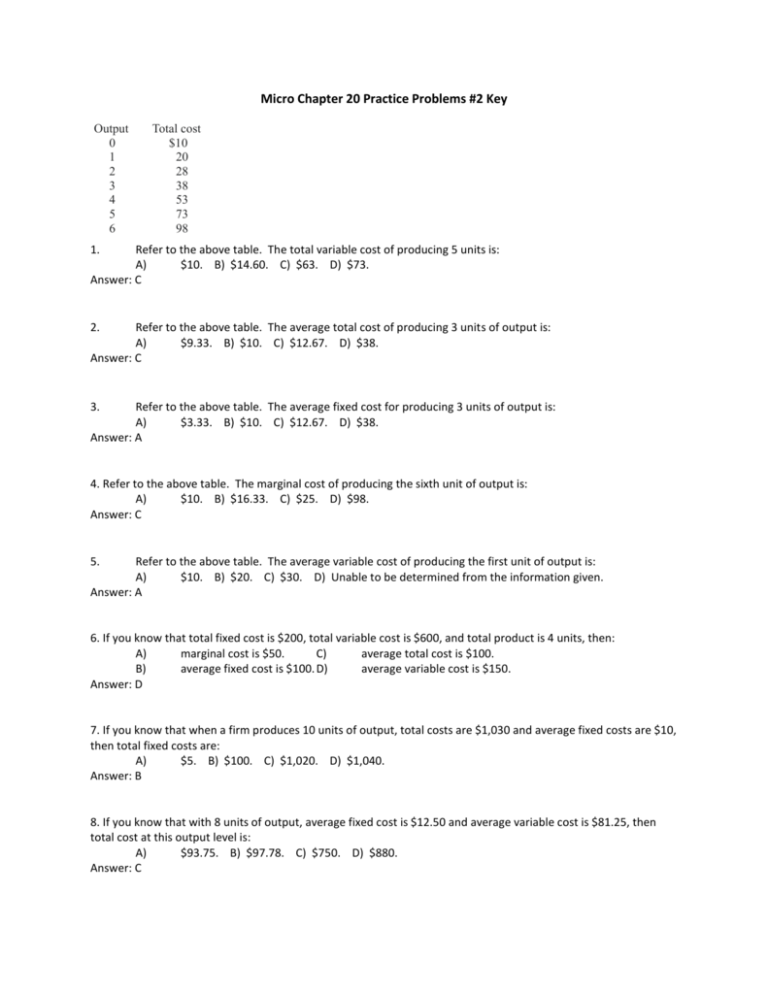
Micro Chapter 20 Practice Problems #2 Key Output 0 1 2 3 4 5 6 Total cost $10 20 28 38 53 73 98 1. Refer to the above table. The total variable cost of producing 5 units is: A) $10. B) $14.60. C) $63. D) $73. Answer: C 2. Refer to the above table. The average total cost of producing 3 units of output is: A) $9.33. B) $10. C) $12.67. D) $38. Answer: C 3. Refer to the above table. The average fixed cost for producing 3 units of output is: A) $3.33. B) $10. C) $12.67. D) $38. Answer: A 4. Refer to the above table. The marginal cost of producing the sixth unit of output is: A) $10. B) $16.33. C) $25. D) $98. Answer: C 5. Refer to the above table. The average variable cost of producing the first unit of output is: A) $10. B) $20. C) $30. D) Unable to be determined from the information given. Answer: A 6. If you know that total fixed cost is $200, total variable cost is $600, and total product is 4 units, then: A) marginal cost is $50. C) average total cost is $100. B) average fixed cost is $100. D) average variable cost is $150. Answer: D 7. If you know that when a firm produces 10 units of output, total costs are $1,030 and average fixed costs are $10, then total fixed costs are: A) $5. B) $100. C) $1,020. D) $1,040. Answer: B 8. If you know that with 8 units of output, average fixed cost is $12.50 and average variable cost is $81.25, then total cost at this output level is: A) $93.75. B) $97.78. C) $750. D) $880. Answer: C 9. If average variable cost is $74 and total fixed cost is $100 at 5 units of output, then average total cost at this output level is: A) $91. B) $94. C) $97. D) $100. Answer: B 10. A firm has fixed costs of $5,000. Its average variable cost is $2.00. At an output of 5,000 units its average total cost is: A) $2.50. B) $3.00. C) $3.50. D) $4.00. Answer: B 11. With fixed costs of $400, a firm has average total costs of $3 and average variable costs of $2.50. Its output is: A) 200 units. B) 400 units. C) 800 units. D) 1,600 units. Answer: C 12. At an output of 1,000 units per year, a firm's variable costs are $5,000 and its average fixed costs are $3. Its total costs per year are: A) $10,000. B) $8,000. C) $6,000. D) $5,000. Answer: B 13. At an output level of 50 units per day a firm has average total costs of $60 and average variable costs of $35. Its total fixed costs are: A) $925. B) $1,250. C) $1,750. D) $3,000. Answer: B 14. Refer to the above graph. It shows the total cost curves. Total fixed cost at output level Q2 is measured by: A) 0B. B) AC. C) CD. D) DE. Answer: C 15. At any level of output: A) average variable cost will exceed average total cost in the short run. B) marginal cost will exceed average variable cost by the level of average fixed cost. C) average variable cost will exceed average fixed cost by the level of average total cost. D) average total cost will exceed average variable cost by the level of average fixed cost. Answer: D 16. Marginal cost can be defined as the: A) change in fixed cost resulting from one more unit of production. B) difference between fixed and variable cost at any level of output. C) amount which one more unit of output adds to total cost. D) difference between price and average total cost at the profit-maximizing level of output. Answer: C 17. When marginal cost is increasing: A) total cost must be increasing. B) average total cost must be increasing. C) average total cost must be decreasing. D) average fixed costs might be increasing or decreasing. Answer: A The fixed cost of the firm is $500. The firm's total variable cost is indicated in the table. Output Tota l variable cost 1 $ 400 2 720 3 1000 4 1400 5 2000 6 3600 18. Refer to the above table and information. The average variable cost of the firm when 5 units of output are produced is: A) $100. B) $200. C) $300. D) $400. Answer: D 19. Refer to the above table and information. The average total cost of the firm when 3 units of output are being produced is: A) $350. B) $400. C) $500. D) $700. Answer: C 20. Refer to the above table and information. The marginal cost of the sixth unit of output is: A) $400. B) $600. C) $1400. D) $1600. Answer: D Output $ 0 1 2 3 4 5 Total fixed cost $200 200 200 200 200 200 Total variable cost $ 0 50 90 120 160 220 Average variable cost $50.00 45.00 4 0.00 40.00 44.00 21. Refer to the above table. The total cost of five units of output will be: A) $290. B) $320. C) $420. D) $500. Answer: C 22. Refer to the above table. The average fixed cost of four units of output will be: A) $40.00. B) $50.00. C) $66.67. D) $100.00. Answer: B 23. Refer to the above table. The average total cost of two units of output will be: A) $90.00. B) $106.67. C) $145.00. D) $250.00. Answer: C 24. Refer to the above table. The marginal cost of the third unit of output is: A) $30. B) $40. C) $45. D) $50. Answer: A Input workers) 0 1 2 3 4 5 Output 0 8 20 28 35 41 TFC 50 50 50 50 50 50 TVC 0 40 80 120 200 Total cost 90 170 210 250 25. Refer to the above table. If output is zero, total cost is: A) $90. B) $50. C) $40. D) $0. Answer: B 26. Refer to the above table. The total cost of producing 20 units of output is: A) $50. B) $80. C) $120. D) $130. Answer: D 27. Refer to the above table. The total variable cost of producing 35 units of output is: A) $90. B) $120. C) $160. D) $210. Answer: C 28. Refer to the above table. The average total cost of producing 35 units of output is: A) $1.41. B) $4.57. C) $6.00. D) $7.00. Answer: C 29. Refer to the above graph. At which point is marginal product (MP) at its maximum? A) point A B) point B C) point C D) point D Answer: A 30. Refer to the above graph. At which point does marginal product (MP) equal average product (AP) at a level of output? A) point A B) point B C) point C D) point D Answer: B 31. If marginal cost is below average variable cost: A) average total cost is increasing but average variable cost is decreasing. B) both average total cost and average variable cost are decreasing. C) both average total cost and average variable cost are increasing. D) average variable cost is less than average fixed cost. Answer: B The following cost data are for a firm in the short run: Output 0 1 2 3 4 5 Total cost $ 400 500 550 600 650 700 32. What is the firm's average variable cost at an output of 5 units? A) $30 B) $60 C) $120 D) $140 Answer: B 33. If marginal cost exceeds average variable cost, then: A) average variable cost must be increasing. B) average total cost must be increasing. Answer: A C) D) average fixed costs must be increasing. marginal cost must be decreasing. 34. At an output of 20,000 units per year, a firm's variable costs are $80,000 and its average fixed costs are $3. The total costs per year for the firm are: A) $80,000. B) $100,000. C) $140,000. D) $240,000. Answer: C 35. A firm encountering economies of scale over some range of output will have a: A) rising long-run average cost curve. B) falling long-run average cost curve. C) constant long-run average cost curve. D) rising, then falling, then rising long-run average cost curve. Answer: B 36. The term diseconomies of scale is reflected in: A) decreasing short-run average costs. B) increasing long-run average costs. D) Answer: B C) increasing short-run marginal costs. decreasing long-run prices. 37. If the long-run average total cost curve for a firm is horizontal in the relevant range of production, then it indicates that there: A) is a minimum efficient scale. C) are diseconomies of scale. B) are constant returns to scale. D) are economies of scale. Answer: B $ Minimun ATC LRATC A 0 B Q 38. Refer to the above graph. There are economies of scale: A) to the left of point A. C) at points A and B. B) to the right of point B. D) between points A and B. Answer: A 39. Refer to the above graph. There are diseconomies of scale: A) to the left of point A. C) at points A and B. B) to the right of point B. D) between points A and B. Answer: B

